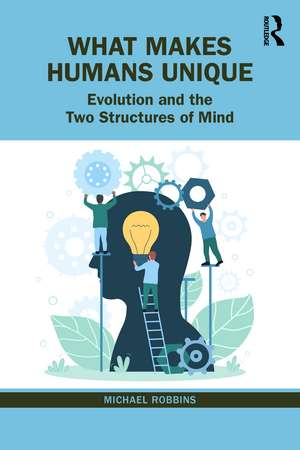What Makes Humans Unique: Evolution and the Two Structures of Mind
Autor Michael Robbinsen Limba Engleză Paperback – 8 sep 2023
As an alternative to Freud’s model of the human mind as structured by the id, ego, and superego, this book contends that the prolonged period of post-natal immaturity – otherwise known as neoteny – which is specific to humans, gives rise to reflective representational thought that in turn allows for the acquisition of complex knowledge. Robbins examines how Freud’s conception of the human mind was limited by his ignorance of the related disciplines of sociology, primatology, cultural anthropology, and most notably evolution, which were then in their infancy, to explore the implications of the non-unitary nature of the human mind for us as individuals, as a society, and for our future as a species.
Drawing on a broad range of influences from psychoanalysis to anthropology, biology, psychology, sociology, and politics, this book will be of interest to students and scholars of these disciplines alike.
| Toate formatele și edițiile | Preț | Express |
|---|---|---|
| Paperback (1) | 308.45 lei 6-8 săpt. | |
| Taylor & Francis – 8 sep 2023 | 308.45 lei 6-8 săpt. | |
| Hardback (1) | 1030.66 lei 6-8 săpt. | |
| Taylor & Francis – 8 sep 2023 | 1030.66 lei 6-8 săpt. |
Preț: 308.45 lei
Preț vechi: 324.68 lei
-5% Nou
Puncte Express: 463
Preț estimativ în valută:
59.03€ • 60.98$ • 49.10£
59.03€ • 60.98$ • 49.10£
Carte tipărită la comandă
Livrare economică 20 martie-03 aprilie
Preluare comenzi: 021 569.72.76
Specificații
ISBN-13: 9781032564920
ISBN-10: 103256492X
Pagini: 132
Dimensiuni: 156 x 234 x 7 mm
Greutate: 0.18 kg
Ediția:1
Editura: Taylor & Francis
Colecția Routledge
Locul publicării:Oxford, United Kingdom
ISBN-10: 103256492X
Pagini: 132
Dimensiuni: 156 x 234 x 7 mm
Greutate: 0.18 kg
Ediția:1
Editura: Taylor & Francis
Colecția Routledge
Locul publicării:Oxford, United Kingdom
Public țintă
Postgraduate and Professional ReferenceCuprins
1. Psychoanalysis and the Structures of Mind 2. The Mental Structure Humans Share with Other Primates and the Structure that is Unique 3. History of the Concept of Two Mental Structures from Psychoanalysis and Other Disciplines 4. The Distinctive Languages of Each Mental Structure 5. The Structure Common to All Species and its Manifestations 6. Acquisition of the Second Mental Structure During the Separation Phase of Development 7. Limitation of the Biological Theory of Evolution in Understanding the Origins of the Second Mental Structure 8. Efforts to Fit What Makes Humans Unique into the Biological Theory of Evolution Lead to the Need for a Revision 9. The Origins of Social Structure from Mental Structure: The Social Organization Derived from the Primordial Structure 10. History of the Parallel Evolution of the Second Mental Structure and the Movement of Human Social Organization from Socio-Centric to Self-Centric 11. The Structural Difference Between Neurosis and Psychosis 12. Mental Structure, Social Organization, and the Complex Interplay of Socially Constructive and Destructive Phenomena Arising From Them 13. Mental Structures and the Evolution of Homo Sapiens
Recenzii
‘Dr. Robbins offers a remarkable psychoanalytic theory of the structures of mind replacing Freud’s tripartite model that incorporates findings from evolutionary biology and primatology. While mankind shares a primordial mind with other animals, the difference is the acquisition of reflection, an ability put on the map by John Locke. It is the ability to speak and to reflect that creates the power to heal.’
Henry Lothane, clinical professor of Psychiatry Icahn School of Medicine
‘Distinguishing the different roles of primordial consciousness and abstract representational thought, this book highlights the limitations of Freud’s model of mental structures and conscious and unconscious mind and proposes a different model. Robbins explores the origins of the capacity to reflect on one’s mind that distinguishes humans from other species. This book is an intellectual tour de force that integrates psychology and psychoanalysis with neurobiology, linguistic and other sciences: a must read for psychoanalysts and for all readers interested in the deepest dimensions of "homo sapiens".’
Riccardo Lombardi, MD, author of Body-Mind Dissociation and Formless Infinity
Henry Lothane, clinical professor of Psychiatry Icahn School of Medicine
‘Distinguishing the different roles of primordial consciousness and abstract representational thought, this book highlights the limitations of Freud’s model of mental structures and conscious and unconscious mind and proposes a different model. Robbins explores the origins of the capacity to reflect on one’s mind that distinguishes humans from other species. This book is an intellectual tour de force that integrates psychology and psychoanalysis with neurobiology, linguistic and other sciences: a must read for psychoanalysts and for all readers interested in the deepest dimensions of "homo sapiens".’
Riccardo Lombardi, MD, author of Body-Mind Dissociation and Formless Infinity
Notă biografică
Michael Robbins is a psychoanalyst, member of the American and International Psychoanalytic Societies, former professor of Clinical Psychiatry at Harvard Medical School, and author of 5 previous books and more than 40 articles in refereed journals.
Descriere
Through an integrated multi-disciplinary theory, Michael Robbins proposes that the human mind consists of two mental structures, the one we share with other animate creatures, and a capacity for reflective representational thought which is unique.
